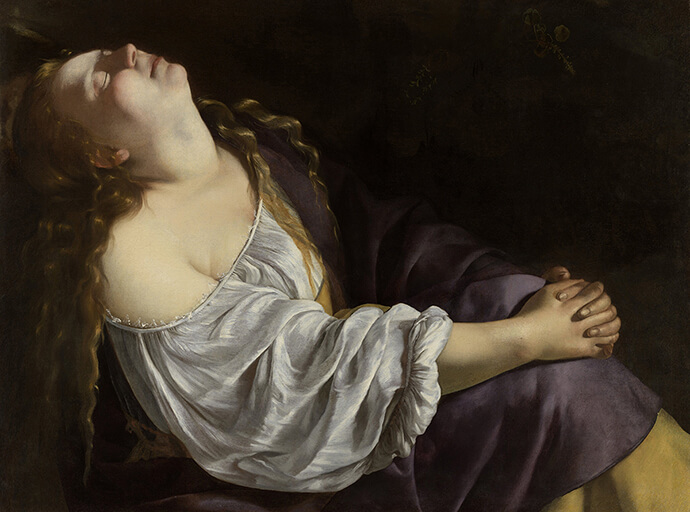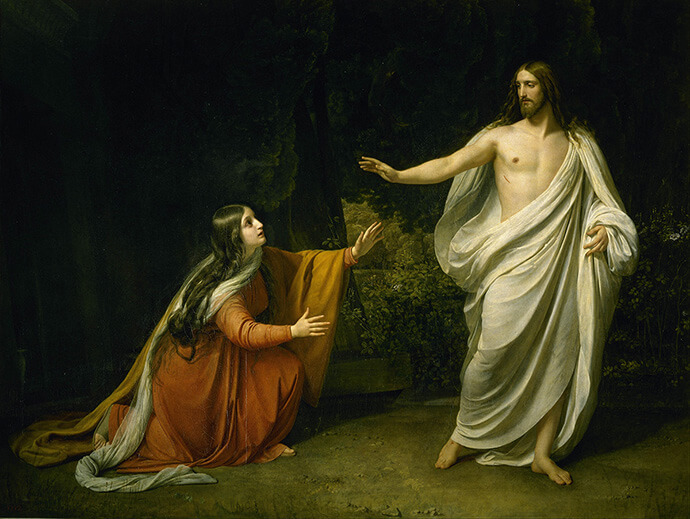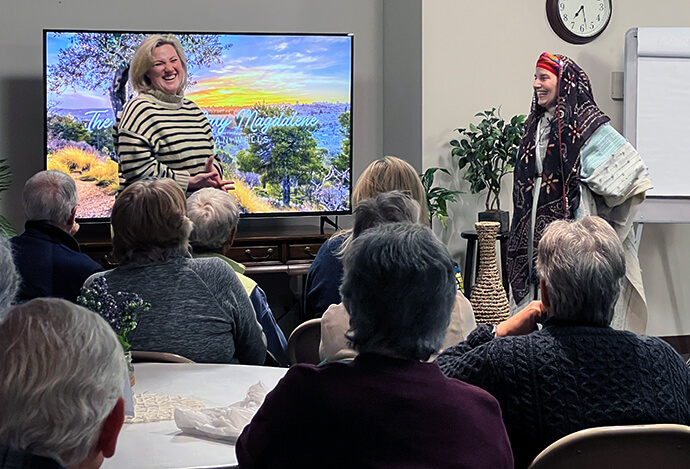Key points:
- Mary Magdalene has a longtime reputation as the Gospels’ bad girl.
- But that reputation does not match what the Bible says about her.
- United Methodists think her example as Jesus’ apostle offers lessons for today when women face a growing backlash around the globe.
Few other followers of Jesus have been saddled with a more notorious reputation than Mary Magdalene.
Sure, she has fame many of today’s celebrities would envy. She’s a popular subject for Renaissance painters with pinup good looks. She plays a starring role in just about every Passion play, TV show and movie made about Jesus’ life.
But all that stardom has come with a price. She’s often portrayed as the former prostitute who is the polar opposite of the Virgin Mary. Or, thanks to the best-selling thriller “The Da Vinci Code,” she’s seen as Jesus’ secret love interest. If she were a celebrity today, she would get salacious headlines on TMZ.

Lost in all the speculation about Mary Magdalene’s love life is the biblical record. Never once does Scripture identify her as a harlot, reformed or otherwise.
Instead, the Bible shows Mary Magdalene as an important disciple of Jesus — the one witness to the Crucifixion and Resurrection whose name appears in all four Gospels. All four note her presence at the empty tomb. In three Gospels, she encounters the risen Christ. In the Gospel of John, she is the first person to testify to the good news that Christ has conquered death.
This Easter Sunday, many United Methodists and other Christians around the world will hear that account in John 20:1-18. The passage features Mary Magdalene’s tearful conversation with a man she first mistakes for a gardener but ultimately recognizes as the risen Savior. She then tells the other disciples, “I have seen the Lord,” and shares what Jesus told her.
Subscribe to our
e-newsletter
“Mary Magdalena is a liberating character in our Scripture,” said the Rev. Stephanie York Arnold, the new head of the United Methodist Commission on the Status and Role of Women.
“Her very being holds the truth we proclaim in our Gospel: What is often cast aside will be raised up, what is often thought less of will be deemed whole, who we often don’t want to include or listen to will likely hold the message of life for us.”
York Arnold, who previously served as the first woman senior pastor at First United Methodist Church in Birmingham, Alabama, takes inspiration from Mary Magdalene.
The United Methodist leader points out that Mary Magdalene is more than a disciple, one who follows Jesus. She is also an apostle — one whom Jesus sends to minister in his name.
In fact, York Arnold uses a title for Mary Magdalene popularized in the medieval church: “Apostle to the Apostles.”
She and other United Methodists say Mary Magdalene’s story is worth revisiting at a time when women’s strides toward equality face growing backlash around the globe.

Equal Measures 2030, a coalition of nongovernmental groups, reports that between 2019 and 2022, nearly 40% of countries — home to more than 1 billion women and girls — either stalled or went backward on gender equality. The index looks at such abuses as increases in domestic violence, child marriages and bans on secondary education.
While women in what is now The United Methodist Church have had full clergy rights since 1956, Mary Magalene’s story still speaks to challenges that church members face.
“Preaching the Gospel is about preaching the Resurrection, and she’s the first to do that,” said Carey Williams Bebar, director of Christian education at Gary United Methodist Church in Wheaton, Illinois. “So her ministry is important as we look at this world right now, particularly when we’re getting more echoes from the ‘manosphere’ and these kind of traditional — I’d sub out patriarchal — arguments that are about oppressing women and about limiting the spaces in which they have power.”
Williams Bebar made Mary Magdalene a focus of this year’s Lenten studies at Gary United Methodist, and she said many in the wider Wheaton community joined in.
Williams Bebar organized a study of “The Mary We Forgot” by Jennifer Powell McNutt, a professor of biblical and theological studies at nearby Wheaton College. Williams Bebar also arranged for McNutt and storyteller Megan Wells, who portrays Mary Magdalene, to give presentations at the church.
The Christian educator, who admires Mary Magdalene so much she named her daughter for the apostle, said the Gospel accounts show how Jesus relied on women in his ministry.
“He not only embraces them and welcomes them,” Williams Bebar said. “He also employs them.”

What the Bible says
The New Testament offers few clues about Mary Magdalene’s background before she followed Jesus.
Many scholars speculate that her last name refers to Magdala, a fishing village in Galilee where she might have grown up.
Another possibility raised by McNutt and other scholars is that her name might be a reference to her character. Magdala means “tower” in Aramaic, and the Gospel writers certainly reveal her to be a tower of faith.
Learn more
Interested in more about Mary Magdalene?
- The Rev. Tiffany McDonald, a United Methodist pastor and blogger in the Minnesota Conference, talks about Mary Magdalene with Crystal Caviness for the Good Friday episode of United Methodist Communications’ “Get Your Spirit in Shape.” The episode will be available on April 18 at the website of “Get Your Spirit in Shape.” McDonald also has the Lenten devotional “Guided by Mary Magdalene.”
- Laura James, a painter and illustrator based in New York, is influenced by Ethiopian Christian iconography in her depictions of people in the Bible. You can see more of her art at her website. You can also see her 10 Stations of the Resurrection, depicting Bible passages after Christ is risen.
Luke first introduces Mary Magdalene with a group of women who support Jesus’ ministry “out of their means.”
The Gospels of Luke and Mark also identify her as a woman Jesus healed of seven demons, though neither specifies the nature of these unclean spirits. What the first-century world labeled demons could refer to spiritual, mental or physical maladies.
“A number of completion, seven indicates that the demons had invaded Mary’s whole life,” writes McNutt and fellow Wheaton College Bible scholar Amy Beverage Peeler in Christianity Today.
The scholars add that Mary Magdalene “amply fulfills her debt of gratitude to Jesus.”
Luke’s listing of women who financially back Jesus is a strong clue that he had women disciples accompanying him, said the Rev. Douglas A. Hume, Ph.D., religion professor and chair of humanities at United Methodist-related Pfeiffer University in Misenheimer, North Carolina.
“Women likely played a much larger role in Jesus’ movement and in the early church than we have evidence for in the New Testament,” he said. “Mary Magdalene’s role in the Resurrection was likely something widely enough known in the early Christian communities that the writers of the Gospels could not suppress it.”
More than a century after Jesus’ earthly ministry, Mary Magdalene remained a popular role model of discipleship in texts not included in the Bible such as the Gospel of Philip and Gospel of Mary.
Hume, who is also a part-time pastor at Badin United Methodist Church in Badin, North Carolina, holds up Mary Magdalene as an example of courage.
“A few years ago I preached on Mary Magdalene and the Resurrection events, and asked where the men were in the story,” Hume recalled. “One of the women in the congregation laughed out loud and said ‘probably drinking.’”
While that’s a humorous take, Hume said he does find it interesting that according to the Gospels, women were brave enough to go out to tend to Jesus’ body. Meanwhile, he said, the men mostly appeared to be behind locked doors “likely cowering in fear, ‘underground’ so the authorities couldn’t apprehend them.”
The women’s gender did not necessarily spare them from danger. In Romans 16:7, Paul lists Junia among the Christian apostles imprisoned with him. A second-century Roman letter notes two female Christian deacons who were tortured.
“We may need Mary Magdalene’s courage today to resist the injustice and evil in the current world,” Hume said.

When the scandal began
In the chapter before Mary Magdalene’s introduction, Luke’s Gospel tells the story of an unnamed penitent woman with an alabaster jar who anoints Christ’s feet with perfumed oil and wets them with her tears.
That may be where some confusion began. But as the church grew and became more established, church fathers found reason to sideline women leaders — including the women named among Jesus’ earliest followers.
“I always say it was the church hierarchy that drove Mary Magdalene to prostitution,” Mark A. Chancey, Ph.D., professor of religious studies at Southern Methodist University in Dallas, told United Methodist News in 2013. He is the author of “The Myth of a Gentile Galilee” and “Greco-Roman Culture and the Galilee of Jesus.”
“Driving her to prostitution fits in the context of putting women in their place.”
You can credit or blame Pope Gregory the Great for fusing Mary Magdalene; Mary of Bethany, the sister of Martha and Lazarus; and Luke’s sinful woman in the popular imagination. In a sermon delivered in A.D. 591, the pope gave the Roman Catholic Church’s official sanction to the view that Mary Magdalene was the promiscuous woman with the alabaster jar whom Jesus redeemed.
Mary of Bethany ended up in the mix because in John’s Gospel she anoints Christ’s feet before the Passion.
The sermon transformed Mary Magdalene into the bad girl of the Gospels, and Gregory’s interpretation prevailed in Western Christianity for nearly 1,400 years.
“She should have been given equal role and opportunity within the Church, but instead her reputation was smeared,” said York Arnold, the Status and Role of Women head.
“Because of that, the whole church has lost out on generations of leaders who could have helped shape our Church and world for good.”
The impact of art
Nowhere was Mary Magdalene’s scandalous reputation more apparent than in art.
Throughout the Middle Ages, miracle plays and pictures frequently showed Magdalene as weeping for her sins. Because of these tearful depictions, the English contraction of Magdalene’s name — “maudlin” — soon took on the connotation of effusive sentimentality.

Mary Magdalene’s story was soon conflated with the legend of Mary of Egypt, a former prostitute turned hermit saint who wandered the desert in repentance. As the story goes, this Mary’s clothes dwindled to nothing leaving her clad only in her own hair.
Renaissance artists, in particular, seemed to use legends surrounding Mary Magdalene as an excuse to paint a scantily clad woman with the church’s blessing.
“From the 18th century onward, Mary Magdalene’s association with prostitution became even more solidified,” writes Brittany E. Wilson, Ph.D., in an essay for the Women’s Bible Commentary. She is a John Wesley Fellow and New Testament professor at United Methodist-related Duke Divinity School.
Wilson said the association stuck in part because of the formation of Magdalene-houses, institutions meant to reclaim women off the street that, all too often, became abusive forced-labor asylums.
Magdalene also became a byword for a fallen woman in the popular literature of the 19th and early 20th centuries.
Rehabilitating Magdalene
In 1969, the Roman Catholic Church officially separated Luke’s sinful woman, Mary of Bethany and Mary Magdalene into three distinct women during a revision of its missal — the book containing the services of Mass throughout the year.
But the change has been slow filtering into the pews and into popular culture. As recently as “The Passion of the Christ” in 2004, Magdalene was still shown as an ex-prostitute.
New York City-based contemporary artist Laura James only thought of Mary Magdalene as a former prostitute when she was commissioned to depict the apostle for a group called FutureChurch. The group seeks changes to allow all Roman Catholics, including women, greater participation in church ministry and governance.
“Working on this absolutely changed my mind,” James said of the work. “It’s telling a fuller story.”
James completed 10 paintings, called The Stations of the Resurrection, which among other images includes Mary Magdalene being commissioned by Jesus as well as Mary Magdalene preaching the Good News. Under each piece is the Bible passage that inspired it.
“Mary Magdalene is essential for confirming the call for women to preach the Good News,” said the Rev. Tiffany McDonald, a United Methodist pastor and blogger in the Minnesota Conference. She has written a Lenten devotional based on Mary Magdalene this year.
“Primarily before and during seminary, and my first few years as a pastor, I named her as an example to those who questioned women’s ability to be pastors,” McDonald said. “‘If it is good enough for all four Gospels, it is good enough for me,’ I would tell the naysayers.”
York Arnold said Mary Magdalene stands as testimony that all are called to proclaim the goodness of the Gospel.
“I think as women we need to claim our place of authority as lay leaders and clergy within the church and not wait for the church to give it to us,” she said. “We have the tenacity to stay near the cross, to visit the tomb and then with profound joy to proclaim there is still life.”
Hahn is assistant news editor for UM News. Contact her at (615) 742-5470 or newsdesk@umnews.org. To read more United Methodist news, subscribe to the free UM News Digest.




